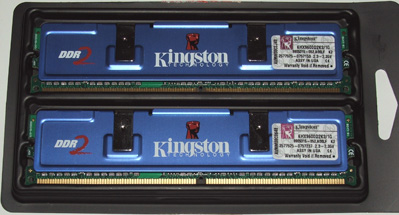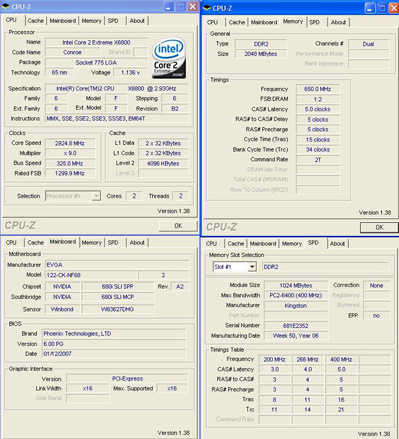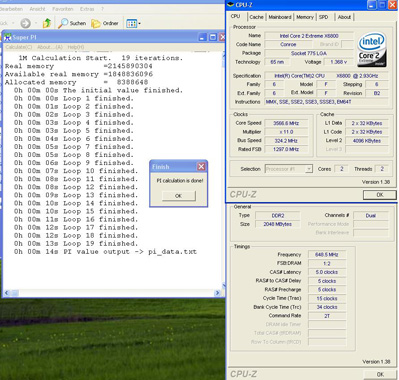Ever since AMD decided to forget about DDR1 and move on to the DDR2 memory, the war between memory manufacturers became even hotter. The market expanded, DDR2 is definitely a standard, and DDR3 with 1333MHz clock-speed is the next step.

But before everyone moves on to DDR3 memory we are going to be continue seeing the epic wars on all possible front lines of the IT society. Right next to Quad core processors, DX10 graphic cards, 1 kilowatt PSU’s, the DDR2 memory is breaking barriers. Giving lifetime warranty on all of his 1200MHz DDR2 modules Kingston gives us a proof that these memory wars are not all about speed but also about the quality and stability.
Take a good look at the picture below as it shows Kingston HyperX 2GB memory with lifetime warranty. This memory even works at 1300MHz.

At the beginning of the year Kingston begun to ship the PC2-9600 modules and at the same time the company showed up with PC2-9200 DIMMs at 1,15GHz. HyperX PC2-9200 and PC2-9600 modules are usually coming in the Dual-Channel kits either as 1 or 2 GB. You can get these super fast modules also as single modules in 512MB or 1GB versions. According to the specifications the memory works at 2,3 – 2,5 volts with 5-5-5-15 latency.
We "started a dance" with 2GB kit “KHX9600D2K2” and with no problem reached 1200MHz. Then we managed to catch a breath at stable 1280MHz.
We used:
EVGA 680i SLI Motherboard
Intel Conroe Core2 Extreme X6800
Kingston HyperX KHX9600D2K2/2G
Leadtek 8800GTS OCZ 700W gameXstream
After we plug all of the components and had the system up and running, we got the booted the memory at 800MHz memory. KHX9600D2K2 memory has been optimized to work at 1200MHz so we went to bios and changed a few settings. We’ve set the frequency at 1200MHz, latency at 5-5-5-15, and raised voltage up to 2.3 volts. Up until recently the 1200MHz speed was as high as you could possibly go, so I was a bit suspicious. I was afraid for no reason as Kingston did a fantastic job with these modules and there was absolutely no problem at the guaranteed 1200MHz. I also have to give the credit to EVGA 680i SLI motherboard. I was getting headaches from this board before, but after all of the bios updates the motherboard is finally stable. User gets to set memory and FSB independently from the processor, and voltages and memory latencies are very flexible and changeable. Also, this is the best overclocker's board on the market.
The processor worked at 2933MHz, and FSB at 1066MHz. In order to see how much does the system gain when using faster memory we used the exact same modules Kingston HyperX KHX9600D2K2 at 800MHz, 1200MHz and 1280MHz. The results at 1300MHz are not there due to the systems instability.
SuperPi
|
Super Pi |
1MB |
8MB |
32MB |
|
Kingston Hyper KHX9600D2K2 800MHz 5-5-5-15 |
143 |
181 |
143 |
|
Kingston Hyper KHX9600D2K2 1200MHz 5-5-5-15 |
146 |
184 |
146 |
|
Kingston Hyper KHX9600D2K2 1280MHz 5-5-5-15 |
147 |
185 |
147 |
Mathematic calculations are very demanding processes that like fast memory. We get to notice that only with increasing complexity and size of operations we actually gain with faster memory. The difference with almost an entire minute at the 32MB size is very noticeable.
Sandra 2007
|
Sandra 2007 |
Memory Bandwith |
Memory BandwithLatency |
Cache&Memory Bandwi |
|
Kingston Hyper KHX9600D2K2 800MHz 5-5-5-15 |
5714/5727 |
81ns / 78.8 |
23165MBs /84.9 |
|
Kingston Hyper KHX9600D2K2 1200MHz 5-5-5-15 |
5736/5745 |
67ns / 65.1 |
24833MBs /71.2 |
|
Kingston Hyper KHX9600D2K2 1280MHz 5-5-5-15 |
5747/5766 |
65ns / 63.0 |
25169MBs /68.6 |
All tests confirm that faster memory means more and better. More memory bandwidth in common language means faster reading and writing into memory, and faster latency shows that PC does not wait as long to access the memory. When you test Cache you want to get the lowest number possible but you want the fastest memory score. Overclocking gave us a bite or two more.
Games: FEAR
|
FEAR |
1024x768 |
1280x960 |
|
Kingston Hyper KHX9600D2K2 800MHz 5-5-5-15 |
181 |
143 |
|
Kingston Hyper KHX9600D2K2 1200MHz 5-5-5-15 |
184 |
146 |
|
Kingston Hyper KHX9600D2K2 1280MHz 5-5-5-15 |
185 |
147 |
|
FEAR High Quality FSAA 4X + Aniso 16X |
1024x768 |
1280x960 |
|
Kingston Hyper KHX9600D2K2 800MHz 5-5-5-15 |
114 |
78 |
|
Kingston Hyper KHX9600D2K2 1200MHz 5-5-5-15 |
115 |
78 |
|
Kingston Hyper KHX9600D2K2 1280MHz 5-5-5-15 |
115 |
80 |
FEAR is very demanding game that can torture even the best graphic cards out there. When we speak of memory, the 3FPS difference we get once we change speeds from 800MHz to 1200MHz is welcome but not great. Additional overclocking to 1280MHz gives us one more frame per second. With Anti Aliasing turned on, we get no any significant improvement due to the limitations of the GPU.
Overclocking and conclusion
Up until now we had no problem with the memory working even at 1280 MHz. It never let us down. Higher speed means more heat, modules are hot and it is normal that the system gets unstable at some point. We managed to reach 1300 MHz, we managed to boot but could not cope with multitasking operations or any more demanding tasks. SuperPi 1MB and 8MB went ok but that was all we managed to benchmark. But let us remind you that up until recently even bare boot of Windows at the 1300MHz speed was impossible, meaning that our modest SuperPi test at these speeds are great result.

Kingston did a marvellous job. If you got the cash and you like speed, then Kingston is definitely good choice. Lifetime warranty and possibility for stable overclocking are what you get with these modules. Kingston is back in the big league and we can welcome them.

